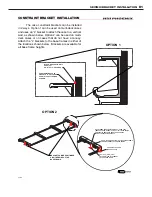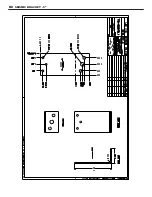
FLOOR PREP
1.
Ask the general contractor if your current copy of the
building dimensions are the most recently issued.
Also, ask for the points of reference from which you
should take dimensions to locate the cases.
2.
Using chalk lines or a laser transit, mark the floor
where the cases are to be located for the entire lineup.
The lines should coincide with the outside edges of the
case feet.
3.
Leveling is necessary to ensure proper case alignment
and to avoid potential case damage. Locate the high-
est point on the positioning lines as a reference for
determining the proper height of the shim-pack level-
ers. A laser transit is recommended for precision and
requires just one person.
4.
Locate basehorse positions along the chalk line. Spot
properly leveled shim packs at each basehorse loca-
tion.
LINE-UP & INSTALLATION
Single Case
1.
Roll the case into position, leaving a minimum of 2"
between the back of the case and the wall. Using a
“J” bar, raise the end of the case (under cross sup-
port), remove the caster assembly (Fig. 1), and lower
the basehorse on to the shim packs. Repeat on the
other end of the case.
2.
Once the basehorse is properly placed on the shim
packs, check the vertical plumb of the case by plac-
ing a bubble level on the rear wall. Add/remove shim
packs as needed. For the horizontal level, repeat this
process after placing the bubble level on the front sill.
Multi-Case
1.
Remove the shelves (discard the shelf clips) and any
loose items from the cases that may interfere with case
joining (e.g. shipping braces, mirror assemblies, etc).
Keep all loose items as they will be used later in
the installation process.
2.
Remove the return air grill at the case joint. The grill
lifts out without fasteners and may be easily removed
to gain clear access to the case-to-case joining bolts.
3.
Follow the single-case installation instructions for the
first case, then position the next case in the line-up ap-
proximately 3’ away. Remove the casters on the end
that is closest to the first case.
4.
Apply the foam tape gasket (supplied) and a bead of
butyl or silicone sealant to the end of the first case (Fig.
2). From the opposite end, push the second case to
a position that is approximately 6" from the first case,
then remove the remaining casters and position case
on the shim packs.
= bolt holes
X = foam tape gasket
O = butyl or silicone sealant
NOTE: It is recommended that cases
be bolted together in the numbered
order indicated in the diagram.
XXX
XXX
XXX
XXX
XXX
XXX
XXX
XXX
XXX
XXX
XXX
XXX
XXX
XXX
XXX
XXX
XXX
XXX
XX
XX
XX
XX
XX
XX
XX
XX
XX
XX
XX
XX
XX
XX
XX
XX
XX
XX
XX
XX
XX
XX
XX
XX
XX
XX
XX
XX
XX
XX
XX
XX
XX
XX
XX
XX
XX
XX
XX
XX
XX
XX
XX
XX
XX
XX
XX
XX
XX
XX
XX
XX
XX
XX
XX
XX
XX
XX
XX
XX
XX
X
XXXXXXXXXXXXXXXXXXXXXXXXXXXXXXXXXXXXXXXXXXXXXXXXXXXXXXXXX XX
XX
XX
XX
XX
XX
OO
OO
OO
OO
OO
OO
OO
OO
OO
OO
OO
OO
OO
OO
OO
OO
OO
OO
O
O
O
O
O
O
O
O
O
O
O
O
O
O
O
O
O
O
O
O
O
O
O
O
O
O
O
O
O
O
O
O
O
O
O
O
O
O
O
O
O
O
O
O
O
O
O
O
O
O
O
O
O
O
O
O
O
O
O
O
O
O
O
O
O
O
O
O
O
O
O
O
O
O
O
O
O
O
O
O
O
O
O
O
O
O
O
O
O
O
O
O
OOOOOOOOOOOOOOOOOOOOOOOOOOOOOOOOOOOOOOOOOOO
O
O
O
O
O
OO
OO
OO
OO
OO
OO
OO
OO
OO
OO
OO
OO
OO
OO
OO
OO
OO
OO
OO
OO
OOO
O
OOO
OO
O
O
OOO
O
OOO
OO
O
O
1
3
5
4
Fig. 2 Bolt holes, foam tape gasket and sealant
2
CASE INSTALLATION
CAUTION!
Be certain that your hands and feet are
out of the way before lowering the case
after the removal of the casters. Failure
to do so may result in serious injury.
Fig. 1 Removing the casters is an easy process. Simply flatten and
remove the cotter pins that are holding the casters in place. Then
lift the case with a “J” bar and slide the caster assemblies out. The
dismantled casters can now be discarded.
COTTER
PIN
CASTER
3
Summary of Contents for 3NDML-NRG
Page 16: ...BLUE WHITE BLACK 3NDML WIRING DIAGRAM B2 ...
Page 19: ...SEISMIC BRACKET 5 D2 ...
Page 20: ...SEISMIC BRACKET 7 D3 ...
Page 21: ...SEISMIC BRACKET 11 D4 ...
Page 22: ...SEISMIC BRACKET 15 D5 ...
























